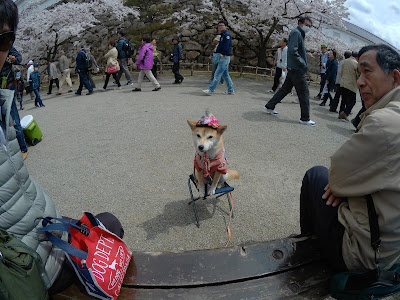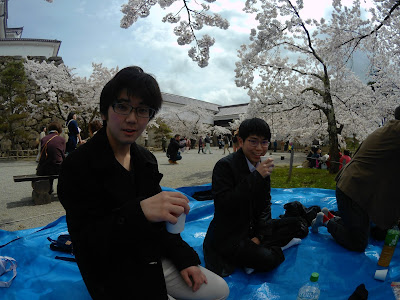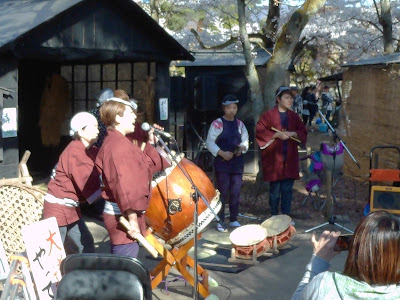This past weekend, there was a massive 花見祭 (hanami matsuri, or flower viewing festival) on the grounds at Tsuruga Castle in the city center. For those of you who don't know what hanami is, it's essentially sitting on a tarp under a bunch of blooming cherry blossom trees, eating snacks and getting drunk with your family and/or friends. Last year, I didn't go to one because I was still new to Japan (and still without a car). This year, as if to make up for last year, I was invited to two. So here's a recap of them both:
DAY 1: WIND ENSEMBLE HANAMI
The University's wind ensemble was holding a hanami for all members to attend on Saturday. I took Tackawanna to the usual coin washing place in the southern portion of the city, then turned around and headed back towards the castle. It was the late morning, and traffic was especially starting to pick up. My intended destination was a coin parking lot to the immediate west of the viewing grounds, which normally serves as a visitor parking lot for the castle. Things looked a little bleak as I passed full parking lots and a message came in from my friends saying that they could not guarantee a parking space for me. Regardless, I turned onto the narrow one-way street, crowded with people, leading to the parking lot.I managed to actually get a space in that lot. As it had turned out, the lot was full, but it was constantly letting cars in and out at that limit, to the point where the sign that said "full lot" and "spaces available" was constantly toggling. I parked in the lot and made the short walk to the flower viewing area to join my friends, who had started to arrive one by one. Our club president had just turned 20, which is the age of majority in Japan, so he was obviously celebrating with a few different drinks, including a Bacardi mojito and chardonnay in a can. Yes, you read the latter part correctly.
 |
| わんわん |
 |
| Instrumentation (L to R): French horn, alto sax, percussion, alto sax |
 |
| Instrumentation (L to R): clarinet, trumpet, percussion, string bass, French horn |
 |
| Instrumentation (L to R): tuba (!!!!!!!), trombone |
While we were sitting together, I remembered that I had not yet been inside the castle yet since I came to Aizu. General admission was 510 yen, but thanks to my international student museum pass provided by the University (which made my friends rather envious), I was granted free entry. Photos weren't allowed in the castle, with the exception of the observation deck, which was where I put my plan into place. After I got to the top, I found the spot where my friends were waiting and signaled out to them. Some of them responded, and I managed to snatch a picture of them from the observation deck.
We parted ways at around 1500 hrs, taking our own tarp and replacing it with another group's, to whom we promised to save them a space. (The area was rather crowded, and the amount of people increased as the day went on.)
DAY 2: STRAIGHT ARROW MOTORS x 9 NINE HANAMI
Saitou-san was holding a joint hanami on Sunday between the two businesses he has ownership in. (The other shop, 9 NINE, is a custom bicycle shop with a store right on the Chuo-dori.) That started later in the afternoon, which gave me enough time to make some food. (There was no participation fee, but patrons were expected to bring their own food to share.) I made some jalapeno hamburger "sliders" (still no hamburger buns available for sale in Aizu) to distribute at the hanami in the afternoon, then packed the car and headed out again.I managed to park again in the same lot. By the time I'd arrived, the hanami was already underway. There were slightly less people in the area compared to yesterday. I distributed my sliders, which received critical acclaim, and tried some of the other food there, including a yakitori platter and an onigiri with grilled meat (wait, those actually exist???). We took some time to visit one of Saitou-san's friends putting on a traditional taiko performance, including a dancing session that they'd repeatedly tried to drag me into and that I'd repeatedly excused myself from.
The late afternoon turned into the early evening, and as everyone started transitioning between the tarp and the steep incline next to us, a hanami party happening right next to us got a little roudy. Saitou-san told me that they were a "small gang"; not affiliated with any larger organization, but had the fashion statement to suggest that they were more than just friends. Somewhere along the 2L cans of Asahi and sake, a guy ended up getting blackout drunk, in a method similar to what happened to me in December, minus the vomiting. His friends were trying to keep him conscious by yelling and slapping his face, which led to a plenty awkward situation of other hanami patrons to just stare straight ahead and say absolutely nothing.
 |
| Saitou-san on the right |
I parted ways shortly before 1800 hrs. Saitou-san and a few others reduced their tarp footprint and stuck around to keep drinking. The lights surrounding the trees turned on automatically. Tomorrow, they said, the cherry blossoms would start shedding from the trees. Summer would be coming soon, given how late the festival was this year.
The weather was absolutely perfect, and I had Tackawanna's top down the whole weekend. I love the warmer weather, and hopefully I'll be able to enjoy it more on the weekends this year instead of staying inside. Next weekend, I'm meeting Saitou-san again. It's his yearly group trip to Costco. I'm so excited for it; needless to say, Tackawanna's true storage capacity will be tested.
-wp




























